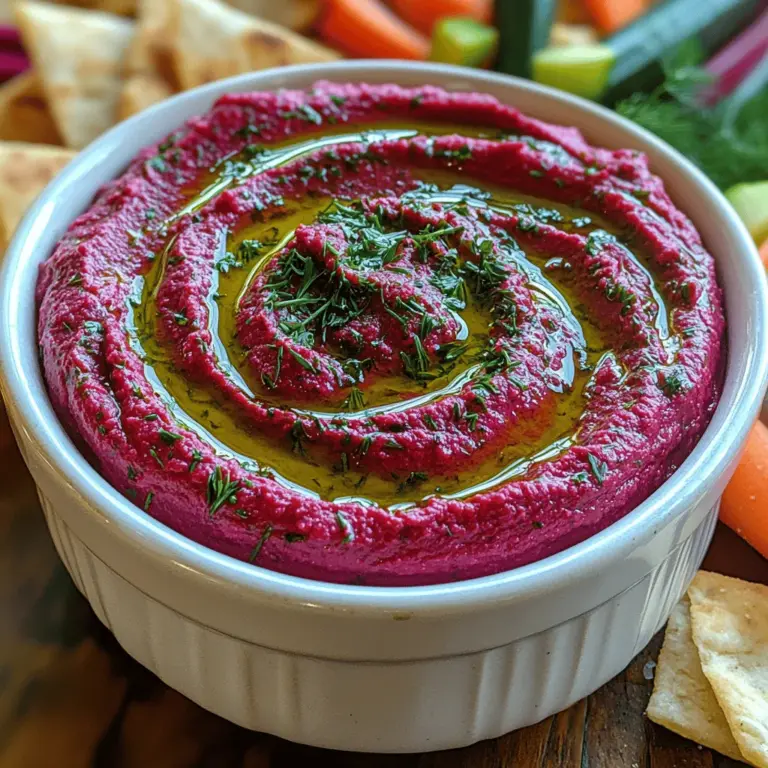Vibrant Creamy Roasted Beet Hummus: A Colorful Twist on a Classic Dip
Hummus has long been celebrated as a staple in Mediterranean cuisine, cherished for its creamy texture, rich flavor, and versatility as a dip or spread. Traditionally made with chickpeas, tahini, and olive oil, this beloved dish has found its place in kitchens worldwide, appealing to health-conscious eaters and flavor seekers alike. With its endless variations, hummus can be customized to suit any palate. Among these adaptations, roasted beet hummus stands out for its stunning color and unique flavor profile. This vibrant dip not only looks beautiful on a platter but also delivers a deliciously earthy taste that elevates the classic recipe to new heights.
The star ingredient, roasted beets, brings more than just striking color to this dish. Beets are packed with essential vitamins and antioxidants, making them a nutritious addition to any meal. They are particularly rich in folate, manganese, and nitrates, which have been linked to improved heart health and enhanced athletic performance. When combined with chickpeas, which are renowned for their protein and fiber content, this hummus becomes a powerhouse of nutrition. The creamy texture derived from tahini and olive oil further enhances the dish, making it a satisfying snack or a healthy appetizer.
In crafting this easy-to-follow recipe, we aim to create a hummus that is not only nutritious but also bursting with flavor. The earthy sweetness of the roasted beets pairs beautifully with the nuttiness of tahini and the brightness of lemon juice, resulting in a dip that is both complex and approachable. Whether served with fresh vegetables, pita bread, or as a spread on sandwiches, this Roasted Beet Hummus is sure to impress friends and family alike.
Understanding the Ingredients
Before diving into the preparation of our Vibrant Creamy Roasted Beet Hummus, it’s essential to understand the key ingredients that contribute to its unique flavor and health benefits.
– Roasted Beets: The cornerstone of this recipe, roasted beets not only give the hummus its vivid magenta hue but also infuse it with a sweet, caramelized flavor. Beets are rich in vitamins A and C, potassium, and dietary fiber. Their antioxidant properties help combat inflammation and support overall health.
– Chickpeas: Also known as garbanzo beans, chickpeas are a fantastic source of plant-based protein, making them an ideal base for hummus. They are high in dietary fiber, which aids digestion and helps maintain stable blood sugar levels. Incorporating chickpeas into your diet can promote satiety, making it easier to manage weight.
– Tahini: This sesame seed paste adds a rich, creamy texture to hummus while providing healthy fats. Tahini is an excellent source of calcium and magnesium, supporting bone health. Its nutty flavor complements the sweetness of the beets beautifully.
– Olive Oil: A staple in Mediterranean cooking, olive oil is known for its heart-healthy monounsaturated fats. It not only enhances the flavor of hummus but also contributes to its smooth consistency. Using high-quality extra virgin olive oil can elevate the overall taste of the dish.
– Garlic: Fresh garlic adds a pungent depth to the hummus, balancing out the sweetness of the beets. Beyond its flavor, garlic is renowned for its health benefits, including immune system support and potential cardiovascular benefits.
– Lemon Juice: Freshly squeezed lemon juice brightens the flavor of the hummus, giving it a refreshing zesty note. It also adds a boost of vitamin C, which is crucial for immune function and skin health.
– Cumin: This warm, earthy spice enhances the overall flavor profile of the hummus, providing a subtle complexity that pairs well with the primary ingredients. Cumin has been linked to various health benefits, including improved digestion and antioxidant properties.
– Fresh Herbs: To finish off the hummus, fresh herbs such as parsley or dill not only add visual appeal but also enhance the flavor. They provide additional nutrients and freshness, making the dish even more delightful.
Preparation Steps for Vibrant Creamy Roasted Beet Hummus
Now that we’ve explored the ingredients and their benefits, let’s move on to the preparation of this eye-catching dip. The process begins with roasting the beets, which is crucial for developing their natural sweetness and enhancing their flavor.
1. Roasting the Beets: Preheat your oven to 400°F (200°C). Start by selecting fresh, firm beets, preferably medium-sized for even cooking. Rinse the beets thoroughly under cool water to remove any dirt. Trim off the leafy tops and the root tail, but leave the skin on to retain moisture during roasting. Wrap each beet individually in aluminum foil, creating a tight package to steam them as they roast. Place the wrapped beets on a baking sheet and roast in the preheated oven for 45 to 60 minutes, or until they are fork-tender. The cooking time may vary depending on the size of the beets.
2. Peeling and Chopping the Beets: Once the beets are roasted, remove them from the oven and allow them to cool slightly before handling. Using gloves (to avoid staining your hands), unwrap the foil and peel the beets. The skin should slip off easily; if not, you can use a paper towel to help remove any stubborn bits. After peeling, chop the beets into smaller pieces to facilitate blending.
3. Blending Ingredients: In a food processor, combine the chopped roasted beets with the drained chickpeas, tahini, olive oil, garlic, lemon juice, cumin, and a pinch of salt. Blend on high speed until the mixture is smooth and creamy. You may need to stop and scrape down the sides of the bowl to ensure even blending. If the hummus is too thick, add a little water or additional olive oil, one tablespoon at a time, until you achieve your desired consistency.
4. Achieving a Smooth Texture: The key to a velvety hummus is thorough blending. Take your time and blend for several minutes to break down the ingredients completely. Taste the hummus and adjust the seasoning if necessary, adding more salt, lemon juice, or cumin to suit your preferences.
As you embark on this delightful culinary journey, you’ll find that creating Vibrant Creamy Roasted Beet Hummus is a straightforward process that rewards you with a nutritious and visually stunning dish. In the following sections, we will explore serving suggestions, storage tips, and ways to incorporate this hummus into your meals, ensuring you can enjoy its vibrant flavor and health benefits in various ways.
{{image_2}}
How to Adjust Consistency and Flavor to Personal Preference
Taste and Texture: Achieving the Perfect Hummus
Creating the perfect hummus is an art that blends taste, texture, and personal preference. When it comes to your vibrant roasted beet hummus, tasting and adjusting flavors is crucial to achieving a dip that resonates with your palate.
Importance of Tasting and Adjusting Flavors
As you prepare your hummus, take the time to taste it at different stages. This not only allows you to gauge the flavors but also helps you understand the impact of each ingredient. You might find that a little more garlic elevates the flavor, or an extra squeeze of lemon adds the brightness you desire. Don’t hesitate to season with salt or freshly ground black pepper to enhance the overall taste.
Suggestions for Customization
– Garlic: If you love garlic, consider adding an additional clove or two. Roasting garlic beforehand can impart a sweeter, milder flavor.
– Lemon: For a zesty kick, increase the lemon juice. Fresh lemon juice is recommended over bottled varieties for the best flavor.
– Salt: A little extra salt can make the flavors pop. Start with a pinch and add more gradually, tasting as you go.
Achieving Desired Creaminess
The texture of your hummus can significantly influence the eating experience. If your hummus is too thick, blend in additional tahini or olive oil, a tablespoon at a time, until you reach the desired consistency. Conversely, if it’s too runny, you can add more chickpeas or a spoonful of tahini to thicken it up. Remember, the key to creamy hummus is to blend it well; high-speed blenders or food processors work wonders in achieving a smooth texture.
Serving Suggestions for Roasted Beet Hummus
Once your hummus is perfectly seasoned and textured, it’s time to think about serving. The vibrant color of roasted beet hummus is eye-catching and can elevate any table setting.
Creative Ideas for Serving
– Dippers: Pair your hummus with freshly baked pita chips, crunchy vegetable sticks like carrots, celery, cucumber, and bell peppers. This provides a delightful contrast in texture and enhances the experience with fresh flavors.
– Spread: Use the hummus as a spread in sandwiches or wraps. It adds a creamy layer and a unique flavor that complements other ingredients beautifully.
Garnishing for Visual Appeal
To enhance the visual appeal of your hummus, consider garnishing with a drizzle of high-quality olive oil, a sprinkle of sesame seeds, or a handful of freshly chopped herbs like parsley or dill. These small additions not only make your hummus look more inviting but also contribute to the flavor profile.
Incorporating Hummus into Meal Planning
Roasted beet hummus is not just a dip; it can be incorporated into various meals:
– Use it as a filling for grain bowls or salads.
– Serve it as part of a mezze platter alongside olives, cheeses, and other dips.
– Pack it as a nutritious snack in lunchboxes, ensuring you have a healthy option available throughout the day.
Health Benefits of Roasted Beet Hummus
This vibrant hummus isn’t just delicious; it’s also packed with health benefits that contribute to a well-rounded diet.
Overview of Health Benefits
– Beets: Roasted beets are rich in antioxidants, vitamins, and minerals, particularly folate, which is crucial for cell function and tissue growth. They also contain dietary nitrates, which can improve blood flow and lower blood pressure.
– Chickpeas: A great source of plant-based protein and fiber, chickpeas help promote digestive health and keep you feeling full longer.
– Tahini: Made from ground sesame seeds, tahini provides healthy fats and is a good source of calcium and magnesium.
Balanced Diet Fit
Incorporating roasted beet hummus into your meals supports plant-based eating habits. It combines ingredients that are nutrient-dense, making it an excellent addition to a balanced diet that prioritizes health without sacrificing flavor.
Storage and Shelf Life
Proper storage is key to enjoying your roasted beet hummus over time.
Tips on Proper Storage
After preparing your hummus, transfer it to an airtight container. This will help maintain its freshness and prevent it from absorbing other odors in the refrigerator.
Keeping It Fresh
Roasted beet hummus can be stored in the refrigerator for up to five days. To keep it even fresher, consider drizzling a layer of olive oil on top before sealing the container. This can help lock in moisture and flavor.
Freezing and Thawing
If you want to make a larger batch for future use, consider freezing your hummus. Portion it into freezer-safe containers or ice cube trays for easy thawing. When you’re ready to enjoy it, simply remove the desired amount from the freezer and thaw in the refrigerator overnight or at room temperature for a few hours. Re-blend if necessary to restore its creamy texture.
Conclusion
In summary, vibrant creamy roasted beet hummus is a delightful and nutritious option for anyone looking to add a splash of color and flavor to their meals. The process of creating this hummus is straightforward, allowing for plenty of customization to fit your personal taste preferences.
From its health benefits to its versatility in serving, this hummus can easily become a staple in your kitchen. We encourage you to experiment with the recipe—perhaps try different spices or toppings—to make it your own. Preparing this colorful dip is not only easy but also a joyful culinary experience that can brighten up any occasion. Enjoy the journey of crafting this delicious hummus, and relish in its vibrant flavors and healthful goodness!


